重庆医科大学:《护理学基础》课程教学资源(PPT课件)14 Body temperature
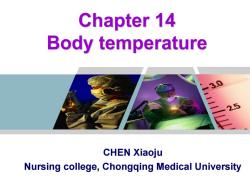
Chapter 14 Body temperature 3.0 2.5 CHEN Xiaoju Nursing college, Chongqing Medical University
CHEN Xiaoju Nursing college, Chongqing Medical University
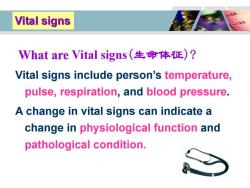
Vital signs What are Vital signs(生命体征)? Vital signs include person's temperature, pulse,respiration,and blood pressure. A change in vital signs can indicate a change in physiological function and pathological condition
Vital signs(生命体征)? Vital signs include person’s temperature, pulse, respiration, and blood pressure. A change in vital signs can indicate a change in physiological function and pathological condition
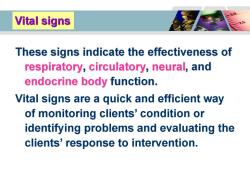
Vital signs These signs indicate the effectiveness of respiratory,circulatory,neural,and endocrine body function. Vital signs are a quick and efficient way of monitoring clients'condition or identifying problems and evaluating the clients'response to intervention
Vital signs are a quick and efficient way of monitoring clients’ condition or identifying problems and evaluating the clients’ response to intervention
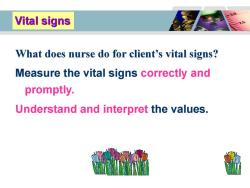
Vital signs What does nurse do for client's vital signs? Measure the vital signs correctly and promptly. Understand and interpret the values
Measure the vital signs correctly and promptly. Understand and interpret the values
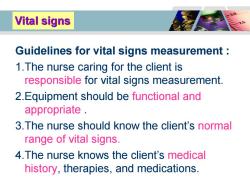
Vital signs Guidelines for vital signs measurement 1.The nurse caring for the client is responsible for vital signs measurement. 2.Equipment should be functional and appropriate 3.The nurse should know the client's normal range of vital signs. 4.The nurse knows the client's medical history,therapies,and medications
Guidelines for vital signs measurement : 1.The nurse caring for the client is responsible for vital signs measurement. 2.Equipment should be functional and appropriate . 3.The nurse should know the client’s normal range of vital signs. 4.The nurse knows the client’s medical history, therapies, and medications
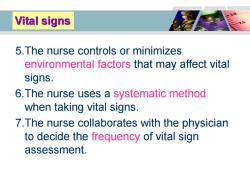
Vital signs 5.The nurse controls or minimizes environmental factors that may affect vital signs. 6.The nurse uses a systematic method when taking vital signs. 7.The nurse collaborates with the physician to decide the frequency of vital sign assessment
5.The nurse controls or minimizes environmental factors that may affect vital signs. 6.The nurse uses a systematic method when taking vital signs. 7.The nurse collaborates with the physician to decide the frequency of vital sign assessment

Vital signs 8.The nurse uses vital signs measurements to determine indication for medication administration. 9.The nurse analyses the results of vital signs measurement. 10.When to take vital signs
8.The nurse uses vital signs measurements to determine indication for medication administration. 9.The nurse analyses the results of vital signs measurement. 10.When to take vital signs
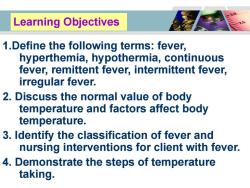
Learning Objectives 1.Define the following terms:fever, hyperthemia,hypothermia,continuous fever,remittent fever,intermittent fever, irregular fever. 2.Discuss the normal value of body temperature and factors affect body temperature. 3.Identify the classification of fever and nursing interventions for client with fever. 4.Demonstrate the steps of temperature taking
Learning Objectives 1.Define the following terms: fever, hyperthemia, hypothermia, continuous fever, remittent fever, intermittent fever, irregular fever. 2. Discuss the normal value of body temperature and factors affect body temperature. 3. Identify the classification of fever and nursing interventions for client with fever. 4. Demonstrate the steps of temperature taking
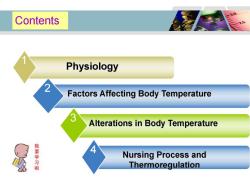
Contents Physiology Factors Affecting Body Temperature Alterations in Body Temperature 我要学习啦 Nursing Process and Thermoregulation
Contents 1 2 3 4
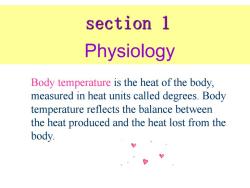
section 1 Physiology Body temperature is the heat of the body, measured in heat units called degrees.Body temperature reflects the balance between the heat produced and the heat lost from the body
Body temperature is the heat of the body, measured in heat units called degrees. Body temperature reflects the balance between the heat produced and the heat lost from the body. Physiology
按次数下载不扣除下载券;
注册用户24小时内重复下载只扣除一次;
顺序:VIP每日次数-->可用次数-->下载券;
- 重庆医科大学:《护理学基础》课程教学资源(PPT课件)13 The Role of Nutrition in Our Health.ppt
- 重庆医科大学:《护理学基础》课程教学资源(PPT课件)17-2 排泄-排尿护理.ppt
- 重庆医科大学:《护理学基础》课程教学资源(PPT课件)16 脉搏与血压.ppt
- 重庆医科大学:《护理学基础》课程教学资源(PPT课件)17-1 排泄-排便护理.ppt
- 重庆医科大学:《护理学基础》课程教学资源(PPT课件)18-1 给药1-2节.ppt
- 重庆医科大学:《护理学基础》课程教学资源(PPT课件)18-3 给药-常用注射法.ppt
- 重庆医科大学:《护理学基础》课程教学资源(PPT课件)18-2 给药-注射术(主讲:姜安丽).ppt
- 重庆医科大学:《护理学基础》课程教学资源(PPT课件)19-1 静脉输液.ppt
- 重庆医科大学:《护理学基础》课程教学资源(PPT课件)19-2 静脉输血.ppt
- 重庆医科大学:《护理学基础》课程教学资源(PPT课件)22 医疗和护理文件记录.ppt
- 重庆医科大学:《护理学基础》课程教学资源(PPT课件)18-4 给药-过敏试验.ppt
- 重庆医科大学:《护理学基础》课程教学资源(PPT课件)21-2 Observe patients’ conditions.ppt
- 重庆医科大学:《护理学基础》课程教学资源(PPT课件)21-1 危重病人抢救技术.ppt
- 重庆医科大学:《护理学基础》课程教学资源(PPT课件)21 临终关怀.ppt
- 重庆医科大学:《护理学基础》课程教学资源(PPT课件)2 健康和疾病.ppt
- 重庆医科大学:《护理学基础》课程教学资源(PPT课件)1 绪论 Introduction to Nursing(主讲:阮莉莉).ppt
- 重庆医科大学:《护理学基础》课程教学资源(PPT课件)6-1 护理学的理论基础.ppt
- 重庆医科大学:《护理学基础》课程教学资源(PPT课件)6-2 护理理论.ppt
- 重庆医科大学:《护理学基础》课程教学资源(PPT课件)4 护士与患者.ppt
- 重庆医科大学:《护理学基础》课程教学资源(PPT课件)3 卫生保健服务.ppt
- 重庆医科大学:《护理学基础》课程教学资源(PPT课件)12-2 Prevention and Care of Pressure Ulcer(压疮).ppt
- 重庆医科大学:《护理学基础》课程教学资源(PPT课件)15 呼吸.ppt
- 重庆医科大学:《护理学基础》课程教学资源(PPT课件)12-1 休息与活动.ppt
- 重庆医科大学:《护理学基础》课程教学资源(PPT课件)11-3 舒适(疼痛).ppt
- 重庆医科大学:《护理学基础》课程教学资源(PPT课件)11-2 舒适.ppt
- 重庆医科大学:《护理学基础》课程教学资源(PPT课件)10 入院与出院护理.ppt
- 重庆医科大学:《护理学基础》课程教学资源(PPT课件)11-1 舒适.ppt
- 重庆医科大学:《妇产科学》课程教学大纲(供五年制临床医学、儿科医学、预防医学专业使用).doc
- 重庆医科大学:《妇产科学》课程教学大纲(供七年制临床医学、儿科医学、预防医学专业使用).doc
- 重庆医科大学:《妇产科学》课程教学资源(授课教案)2005级5年制《异常分娩》教案3学时.doc
- 重庆医科大学:《妇产科学》课程教学资源(授课教案)2005级5年制预防系和影响系《计划生育》教案2学时.doc
- 重庆医科大学:《妇产科学》课程教学资源(授课教案)2004级7年制《女性盆底功能障碍性疾病》教案2学时.doc
- 重庆医科大学:《妇产科学》课程教学资源(授课教案)2005级5年制《不孕症》教案2学时.doc
- 重庆医科大学:《妇产科学》课程教学资源(授课教案)滋养细胞疾病教案3学时-5,7年制.doc
- 重庆医科大学:《妇产科学》课程教学资源(授课教案)2005级5年制《闭经》教案2学时.doc
- 重庆医科大学:《妇产科学》课程教学资源(授课教案)2005级5年制《功血》2学时.doc
- 重庆医科大学:《妇产科学》课程教学资源(授课教案)2005级5年制《围绝经期综合征》教案2学时.doc
- 重庆医科大学:《妇产科学》课程教学资源(授课教案)2004级7年制《子宫内膜异位症》教案3学时.doc
- 重庆医科大学:《妇产科学》课程教学资源(授课教案)2004级《宫颈癌》教案2学时.doc
- 重庆医科大学:《妇产科学》课程教学资源(授课教案)2004年7年制《子宫内膜癌教案》2学时.doc
